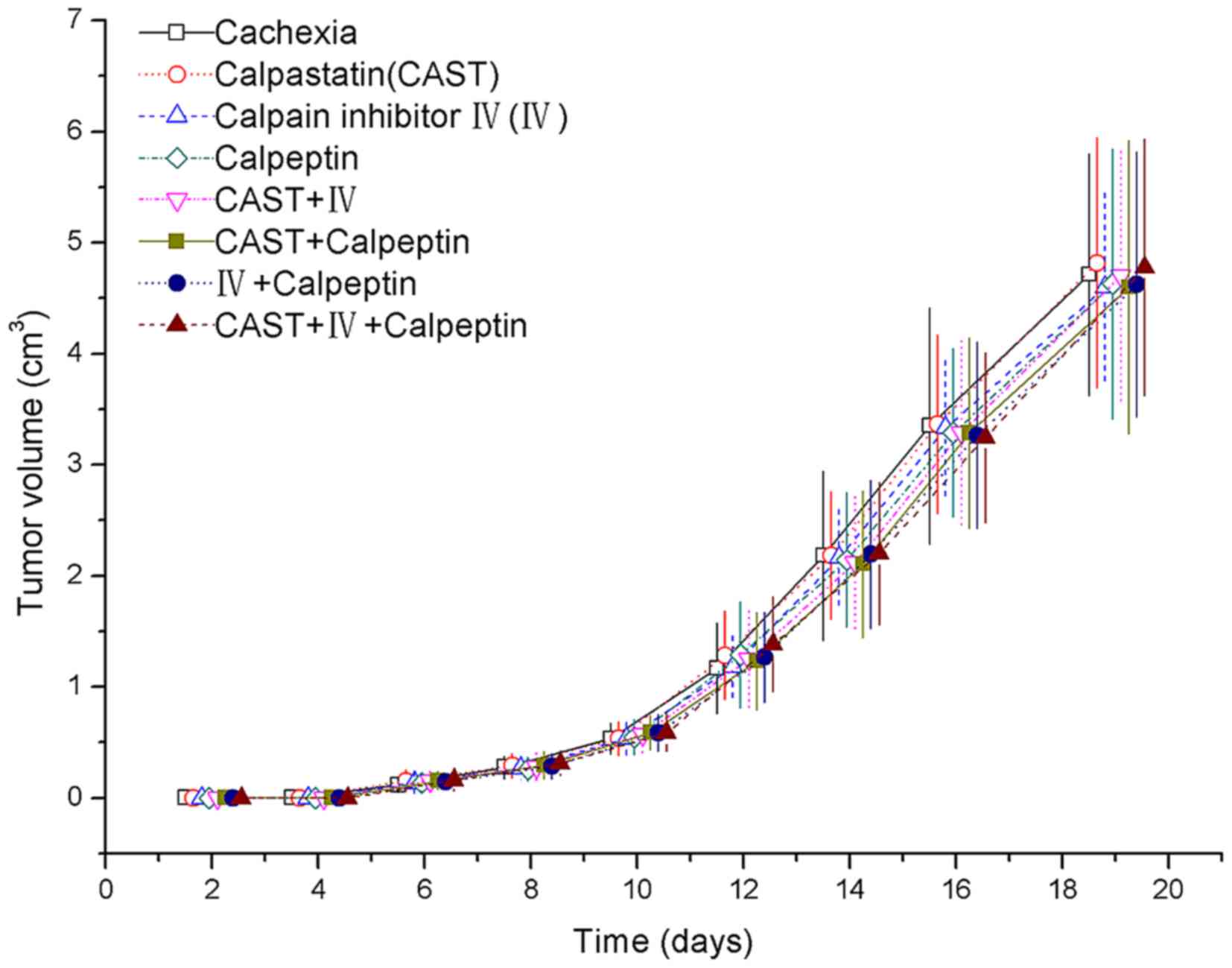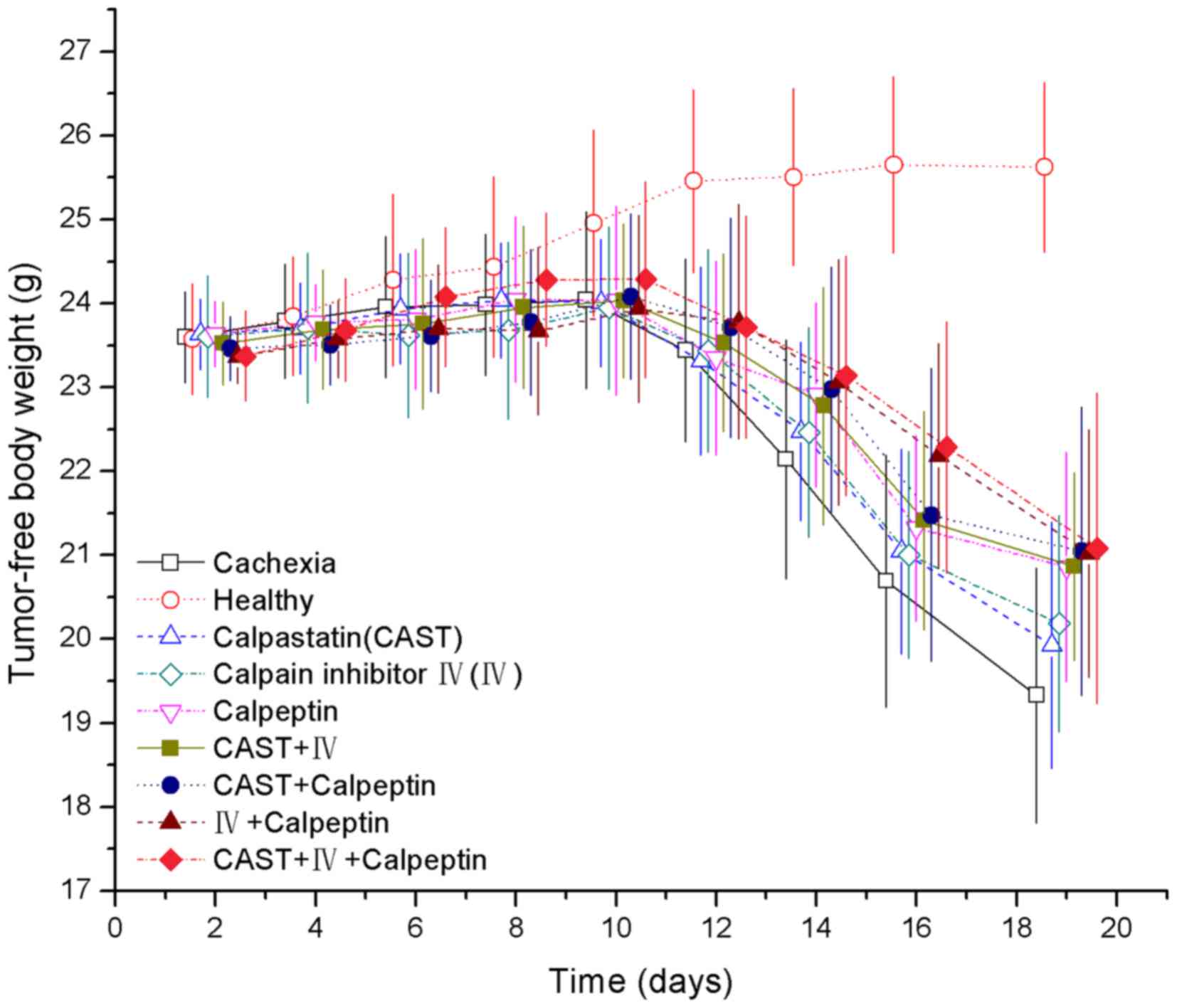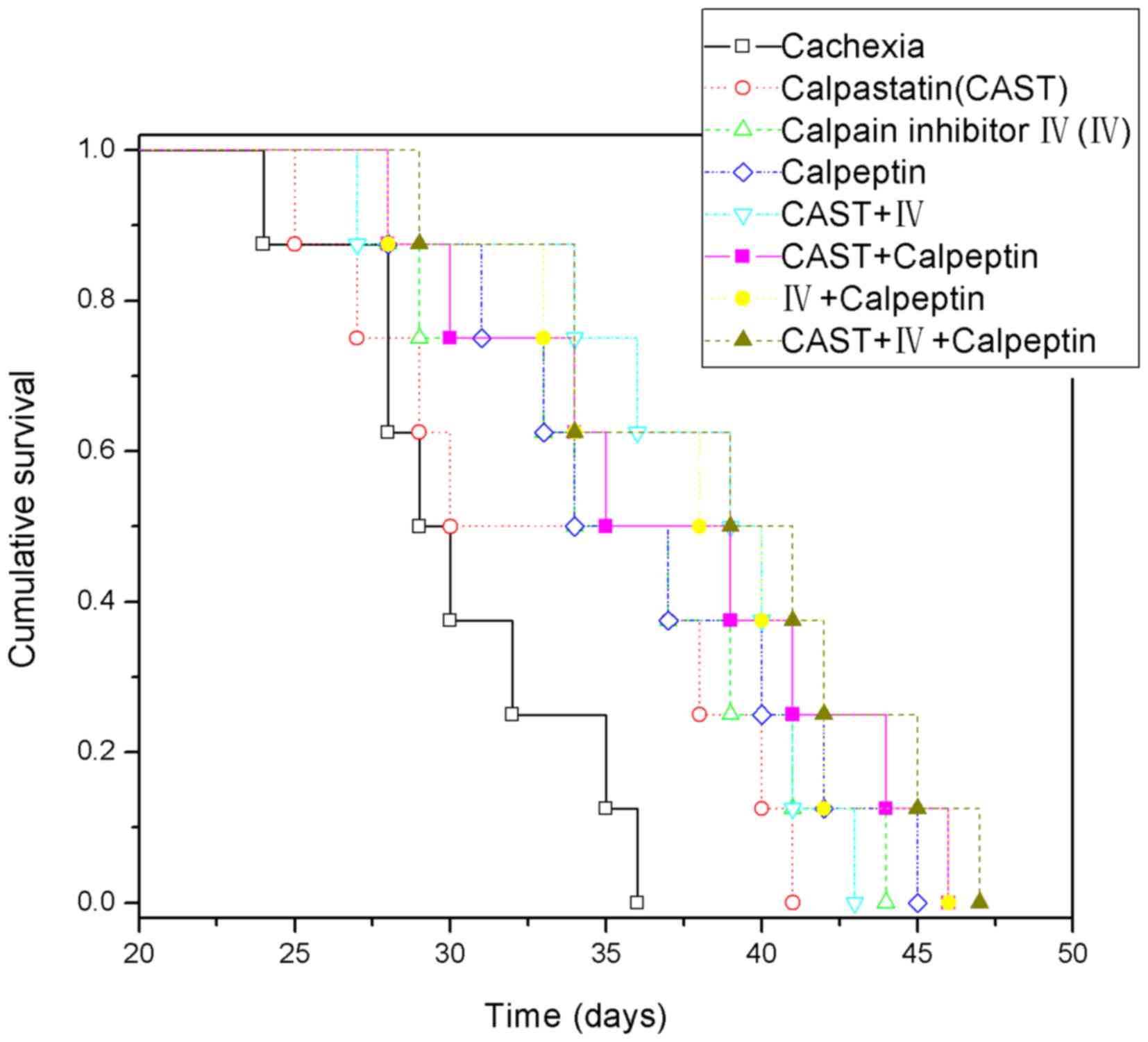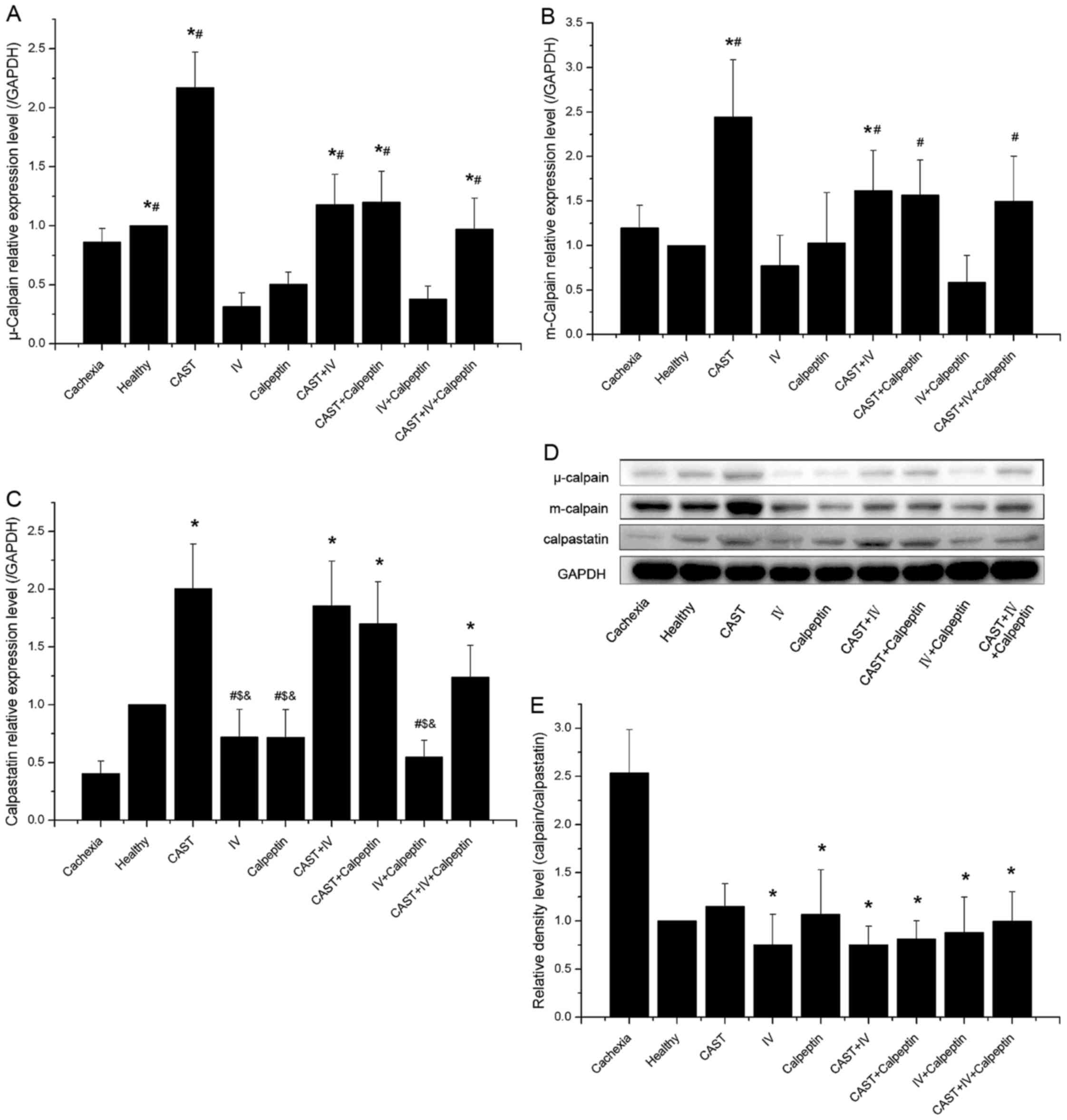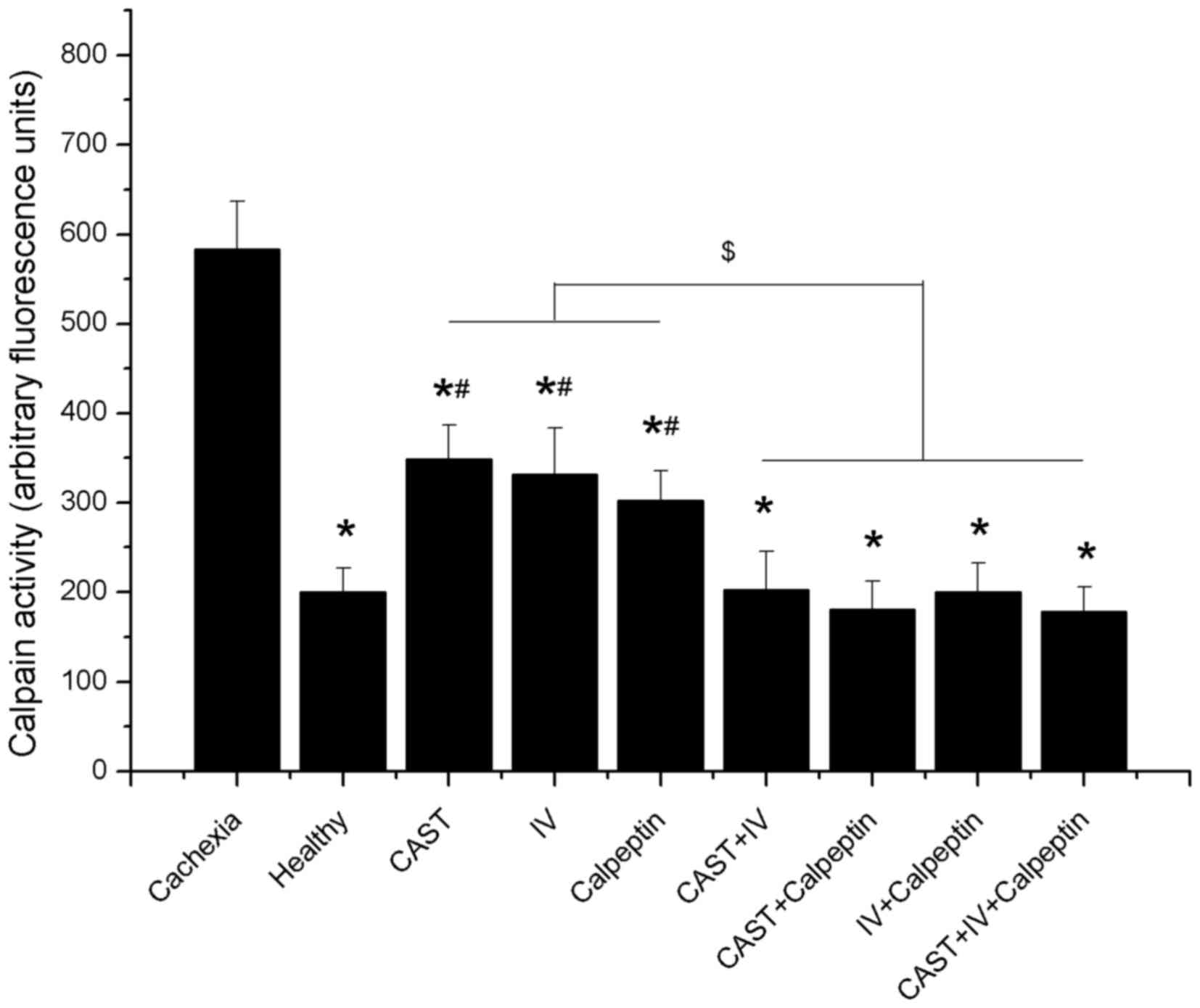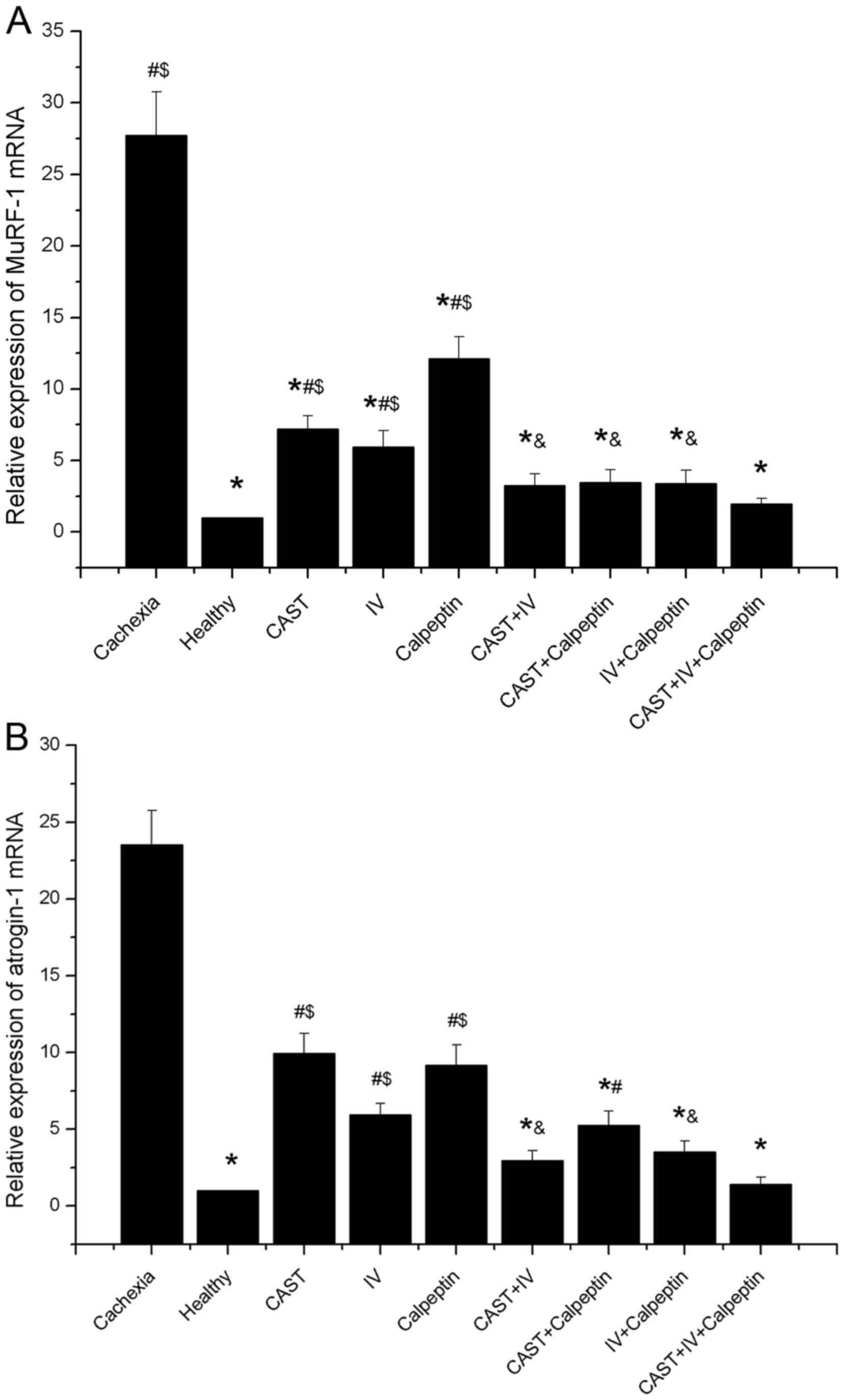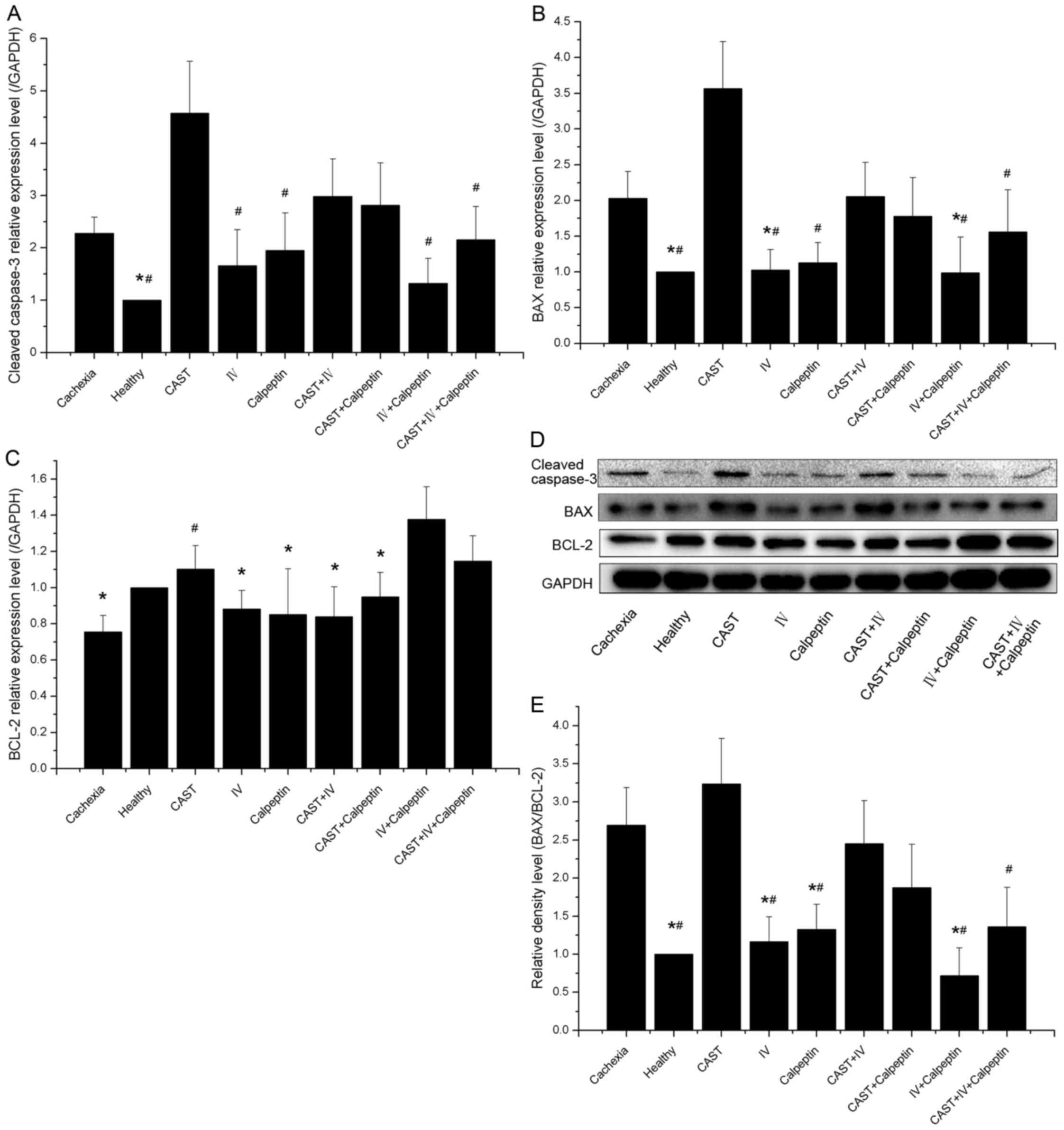Calpain inhibitors ameliorate muscle wasting in a cachectic mouse model bearing CT26 colorectal adenocarcinoma
- Authors:
- Published online on: January 20, 2017 https://doi.org/10.3892/or.2017.5396
- Pages: 1601-1610
Abstract
Introduction
Cancer cachexia is a multifactorial syndrome characterized by a progressive loss of skeletal muscle mass that cannot be fully compensated for by conventional treatments such as increasing energy intake through nutritional support (1). Approximately 60–80% of all advanced cancer patients experience cachexia, particularly those with gastric and pancreatic cancers (2). Cachexia is associated with decreased physical function, impaired quality of life, and shortened survival time (3), and is responsible for roughly 20% of all cancer deaths (4). With growing incidence and high mortality, it also increases health care resource utilization and associated hospitalization costs, and has become a major social health problem (5). Since a significant unmet need exists for improving patients' quality of life and decreasing the public health burden, it is critical to clarify the mechanism of this debilitating condition.
As the most important feature of cancer cachexia, skeletal muscle atrophy is believed to be due to a significant increase in proteolysis of myofibrils (6). Although mounting evidence indicates that the ubiquitin-proteasome pathway (UPP) plays a prominent role in the process (7,8), the proteasome only degrades peptides by engulfing them in its catalytic chamber and cannot disassemble myofibrillar proteins until they have been released from the myofibrils as myofilaments by the calpain system (6). Furthermore, evaluation of muscle biopsies in clinical trials suggests that muscle apoptosis exists in this hypercatabolic state, which contributes to the severity of the cachexia (9).
Calpain, a member of the calcium-activated cysteine protease family, is implicated in diverse diseases, including muscular dystrophy, neurological disorders, cataracts, and hematonosis (10). Inhibition of calpain can preserve the function of critical proteins by suppressing associated proteolysis, thus potentially ameliorating these diseases. In terms of cachexia-induced muscle wasting, calpain and UPP have a synergistic effect on muscle protein proteolysis, as calpains can provide substrates for UPP when activated (11). In addition, calpain inhibitors prevent calpain-mediated neuron apoptosis in several rodent models of nervous system injury (12,13). These inhibitors thus might also protect skeletal muscle from cachexia-induced apoptosis.
In this study, we evaluated the effect of three common calpain inhibitors, calpastatin (an endogenous polypeptide inhibitor), calpain inhibitor IV, and calpeptin (both irreversible inhibitors derived from chemical synthesis) on skeletal muscle proteolysis and apoptosis in a murine model of cancer cachexia.
Materials and methods
Reagents and cell line
Calpastatin peptide (CAST for short), calpain inhibitor IV (IV for short) and Calpeptin (Merck Millipore, Boston, MA, USA, catalogue no. 208902, 208724, 03-34-0051) were resolved with dimethyl sulfoxide (DMSO) as a stock solution and diluted in sterile saline solution before use. Primary antibodies [rabbit monoclonal anti-calpain 1 (ab108400; 1:1000); rabbit monoclonal anti-calpain 2 (ab126600; 1:1000); rabbit polyclonal anti-calpastatin (ab28252; 1:5000); rabbit monoclonal anti-Bax (ab32503; 1:1000); rabbit polyclonal anti-Bcl-2 (ab59348; 1:1000); mouse monoclonal anti-GAPDH (ab9484; 1:1000)] were purchased from Abcam (Cambridge, UK), rabbit polyclonal anti-cleaved caspase-3 (Asp175) (cat# 9661; 1:1000) was obtained from Cell Signaling Technology (Danvers, MA, USA), and secondary goat anti-rabbit IgG (BA1055; 1:3000) and goat anti-mouse IgG (BA1050; 1:3000) conjugated with horseradish peroxidase were obtained from Boster (Wuhan, China). Colon carcinoma cell line CT26 was purchased from American Type Culture Collection (Manassas, VA, USA).
Design of animal experiments
BALB/c male mice (6–8 weeks old, body weight 20–24 g) were purchased from the Animal Center of the Chinese Academy of Sciences (Shanghai, China; Security processing facility certificate number SCXK (Hu) 2012-0002). The animals were maintained in a specific pathogen-free environment at a controlled temperature (22±1°C) and a 12 h light-dark cycle, which was provided by the Animal Experiments Center of Fujian Medical University. All animals were fed with standard laboratory chow and tap ad libitum. The protocol was approved by the Institutional Animal Care Committee of the Fujian Medical University.
After 7 days of acclimation, a total of 144 mice received CT26 cells as subcutaneous injections in the right armpits, with a homogenate of 50 mg (2–3 mm3) minced solid murine CT26 adenocarcinoma in 0.1 ml of saline, while 18 mice were injected with saline alone as healthy controls. The tumor-inoculated animals were randomly divided into the eight groups as follows: CAST, IV, calpeptin, CAST+IV, CAST+calpeptin, IV+calpeptin, CAST+IV+calpeptin, and cachexia control group (n=18 per group). Intraperitoneal administration of CAST (1.5 µg/kg, daily), IV (0.75 mg/kg, daily), and/or calpeptin (1.75 mg/kg, daily) at a total volume of 0.2 ml began on the 12th day after inoculation, when the mice presented signs and symptoms of cachexia, and lasted for 7 consecutive days. Besides the above mentioned healthy controls, 18 mice of the cachexia control group also received an equal volume of DMSO+saline i.p. once daily for one week in parallel. Physical activity, fur condition, body weight, food intake, and tumor growth were recorded daily. The tumor volume was calculated according to the following method: tumor volume V (cm3) = (axb2)/2, where a is the length and b is the width.
On the 19th day, ten mice in each group were randomly sacrificed, and their blood, tumors, and gastrocnemius muscles were collected for further analysis. After being obtained from orbital veins and clotting for 1 h, blood samples were centrifuged at 1200 × g for 10 min, the serum was collected and stored at −20°C. After the animals were euthanized by cervical dislocation, both their gastrocnemius muscles from the left leg and tumors were harvested and weighed. The gastrocnemius muscles were then snap-frozen in liquid nitrogen and stored at −80°C. Survival time for the remaining eight mice from each group was monitored and analyzed.
Bioanalytical assays
Serum glucose, triglyceride, total protein, and albumin used as biochemical markers of nutritional status were measured by an Olympus AU2700 automated biochemistry analyzer (Olympus, Tokyo, Japan).
Calpain activity assay
Calpain activity was measured by a calpain activity assay kit (Biovision, Mountain View, CA, USA). An appropriate amount of muscle tissue was ground into powder in liquid nitrogen. The fine powder was then lysed with extraction buffer in the kit and placed on ice for 20 min. After centrifuging in a microcentrifuge at 10,000 × g for 5 min, the supernatants were collected. After protein quantification using a Bradford protein assay kit (Wanleibio, Shenyang, China), 100 µg of protein was incubated with calpain substrate Ac-LLY-AFC in a dark fluorescent microplate at 37°C for 1 h. The samples were read in a SpectraMax M5 microplate reader (Molecular Devices, Sunnyvale, CA, USA) equipped with a 400 nm excitation filter and a 505 nm emission filter.
Western blot analysis
The muscle specimens were homogenized and lysed in RIPA buffer mixed with protease inhibitors (150 mM NaCl, 50 mM Tris pH 7.4, 1% Triton X-100, 1% sodium deoxycholate, 0.1% sodium dodecyl sulfate, sodium orthovanadate, sodium fluoride, ethylenediaminetetraacetic acid, and leupeptin). After centrifugation at 12,000 × g for 5 min at 4°C, the resulting proteins were quantified with a bicinchoninic acid protein assay kit (Beyotime, Shanghai, China). Proteins were separated by SDS-polyacrylamide gel electrophoresis according to their molecular weight using a mini-gel electrophoresis system (Bio-Rad, Hercules, CA, USA) and subsequently transferred onto a polyvinylidene difluoride membrane (Millipore, Billerica, MA, USA). The membrane was blocked with 5% bovine serum albumin at room temperature for 1 h, then incubated with primary antibodies overnight at 4°C, and further incubated with horseradish peroxidase-conjugated anti-rabbit or mouse IgG for 1 h at room temperature. The protein bands were illuminated with enhanced chemiluminescence reagents (Gen-View Scientific, Inc., Calimesa, CA, USA) and detected by the ChemiDoc XRS+ system (Bio-Rad). Finally, optical density values were normalized to that of the housekeeping protein glyceraldehyde-3-phosphate dehydrogenase (GAPDH) and analyzed with ImageJ computer software (NIH, Bethesda, MD, USA). The average values were obtained from three repeated measures.
Quantitative real-time PCR
RNA of collected tissue was isolated using a tripure isolation reagent (Roche Diagnostics, Indianapolis, IN, USA). cDNA was synthesized from 3 µg total RNA using the First Strand cDNA Synthesis kit (Gen-View Scientific, Inc.) according to the manufacturer's instructions. Semi-quantitative real-time PCR analysis was performed using an Applied Biosystems 7500 Real-time PCR System (Applied Biosystems, Carlsbad, CA, USA) with SYBR-Green staining of DNA double-strands, while the staining was performed using the FastStart Universal SYBR Green Master (Roche Diagnostics) according to the product manual. Primer pairs for the amplification of E3 ubiquitin ligase genes were the following: mouse MuRF-1 (sense: 5-GGAACACGAAGA CGAGAAAATC-3, antisense: 5-TGGCTATTCTCCTTGG TCACTC-3); mouse atrogin-1 (sense: 5-GAAGAGAGCAGT ATGGGGTCAC-3, antisense: 5-CTTGAGGGGAAAGRG AGACG-3); and mouse GAPDH (sense: 5-GGTGAAGGTCG GTGTGAACG-3, anti-sense: 5-CTCGCTCCTGGAAGAT GGTG-3). The amplification conditions were as follows: 50°C for 2 min, 95°C for 10 min, and 40 cycles at 95°C for 15 sec and 60°C for 1 min. Finally, either target gene expression was normalized to the housekeeping gene mouse GAPDH that was amplified at the same time, and further analyzed using the 2−∆∆CT method (14).
Statistical analyses
All data were expressed as mean ± standard deviation. Differences were examined for significance using one-way ANOVA followed by Tukey's pos-hoc test with SPSS 19.0 software (SPSS, Chicago, IL, USA). The Kruskal-Wallis test followed by the Nemenyi test was used when the data distribution was skewed. The log-rank test was used for survival analysis. All statistical analyses were two-sided, and P-values of 0.05 were considered statistically significant.
Results
Tumor volume
The tumors of CT26-inoculated mice were perceptible by day 6, and grew more rapidly from day 10 onward. The mice exhibited symptoms of cachexia on day 12 after tumor inoculation, including delayed responsiveness, poor physical activity, scruffy fur, piloerection, and darkening of dorsal hairs. All the tumor-bearing groups had a significant increase in tumor volume over time but no significant differences were observed between the treatment groups and the cachexia control group (Fig. 1).
Tumor-free body weight
There was no difference in initial body weight among the nine groups (Fig. 2). As the body weight of the healthy control group grew during the study period, the weight of the tumor-bearing groups increased during the first 8 days then declined from day 9 to the final day, despite a slight transient increase in some groups (Fig. 2). From days 16–19, the tumor-free body weight of the IV+calpeptin and CAST+IV+calpeptin groups were significantly higher than the cachexia group (P=0.03, P=0.016 and P=0.015, P=0.011, respectively). A significant tumor-free body weight increase was observed in the calpeptin, CAST+IV, and CAST+calpeptin groups only on day 19 (P=0.045, P=0.045, P=0.014, respectively). However, the tumor-free body weight of all tumor-bearing groups was significantly different from that of the healthy controls from days 12–19 (P<0.01). Cumulative food intake of standard chow showed no significant difference during the experiment (data not shown).
Muscle weight and serum nutritional markers
Significant loss of gastrocnemius wet weight was found in the cachexia controls as compared to the healthy controls (Table I, P<0.001). There were also significant differences in gastrocnemius weight between any treatment group and the cachexia group (P<0.001). Moreover, a markedly increased gastrocnemius muscle mass was observed in the IV+Calpeptin and CAST+IV+calpeptin groups compared with the CAST and IV groups (P=0.002, P=0.001 and P=0.004, P=0.001, respectively).
Table I.Initial body weight of each group and effect of different calpain inhibitors on gastrocnemius muscle mass and serum metabolic parameters (mean ± SD), (n=10 each). |
To evaluate the effect of treatments with different calpain inhibitors on the nutritional state of cachectic mice, we measured the serum levels of serum total protein, albumin, glucose, and triglycerides in the nine groups. Mice from the cachexia group had lower levels of total protein, albumin, and glucose, and higher levels of triglycerides (Table I, P<0.01) compared with the healthy controls. The administration of different calpain inhibitors could partially reverse these metabolic changes, especially the combination treatment with two or three kinds of inhibitors. However, no significant difference in these markers was found between any mono-treatment group and the cachexia controls (between the CAST group and the cachexia group, P=0.999, P=1.000, P=1.000, P=1.000; between the IV group and the cachexia group, P=0.581, P=0.352, P=1.000, P=0.961; between the calpeptin group and the cachexia group, P=0.994, P=0.903, P=0.392, P=0.862).
Survival time
To evaluate the effect of the different treatments on the survival time of mice, we constructed Kaplan-Meier curves with 8 mice in each group (eight remained alive after the other ten were sacrificed on day 19). The data demonstrated that most of the treatment groups had a longer survival time than the cachexia group (Fig. 3, P<0.05) except for the calpastatin group (P=0.101). In addition, there were no significant differences among the different treatment groups (P>0.05). All mice in the healthy control group survived for 50 days.
Calpain expression and activity
Previous studies (15) have shown that activation of the calpain system is ubiquitous in cancer cachexia, and calpain inhibitors can antagonize the effects induced by activated calpain. To confirm that treatments with different calpain inhibitors affect calpain expression and activity in cachectic mice, we measured the levels of µ-calpain, m-calpain, and calpastatin, and examined the calpain activity in all nine groups.
There were no significant differences in either µ-calpain or m-calpain protein expression between the cachexia controls and the healthy controls. Treatment with calpain inhibitor IV and calpeptin were associated with lower levels of the two ubiquitous calpains; however, their levels in the calpastatin group were higher than the control groups and the other mono-treatment groups, while their expression could be downgraded when combined with other calpain inhibitors such as calpain inhibitor IV, calpeptin, or both (Fig. 4A, B and D).
Lower levels of calpastatin were observed in the muscle of tumor-bearing mice compared to the healthy controls, except for the groups affected by exogenous calpastatin. Compared with groups not involving calpastatin, there were significant higher levels of calpastatin in the groups treated with calpastatin peptide alone or combined with other inhibitors. In addition, administration with other inhibitors could decrease the levels of calpastatin (Fig. 4C and D).
In accordance with a previous study (16), we found that both the levels of µ-calpain and m-calpain remained unchanged in the cachexia and healthy controls during the experiment (P>0.05), but the calpastatin level showed a progressive decrease after tumor transplantation, resulting in a rising imbalance of the calpain/calpastatin ratio. Moreover, the ratio of calpain to calpastatin had a positive correlation with calpain activity (Figs. 4E and 5). The present study indicated that the levels of µ-calpain, m-calpain, and calpastatin expression in tumor-bearing mice were affected by different inhibitors and that the ratio of calpain to calpastatin and the calpain activity was reduced through the administration of any inhibitor alone or in combination.
Expression of atrogin-1 and MuRF-1 mRNA
To characterize the effects of calpain inhibitors on muscle atrophy, mRNA levels of atrogin-1 (MAFbx) and MuRF-1 were measured. Results from qRT-PCR analyses revealed that atrogin-1 and MuRF-1 were significantly greater in all cachexia mice than in the healthy controls (approximately a 20-fold increase). The mono-treatment of calpain inhibitors significantly downgraded MuRF-1 levels by 74, 79, and 56% and atrogin-1 levels by 58, 75, and 61%, respectively, compared to the cachexia control group. Further reductions were observed when these inhibitors were administrated together (Fig. 6A and B).
Expression of apoptosis-related protein
To evaluate the effect of calpain inhibitors on apoptosis, we measured the expression of several widely used apoptosis-related proteins, including caspase-3, BAX, and BCL-2. Our results confirmed that apoptosis was present in skeletal muscle of cachectic mice, as there were significantly higher caspase-3 and BAX protein levels and lower BCL-2 levels in cachexia control animals as compared to those observed in the healthy animals. Mono-treatment with calpain inhibitor IV, calpeptin, or both was associated with a decrease in the expression of caspase-3 and BAX and an increase in the expression of BCL-2, which decreased the BAX-to-BCL-2 ratio. Conversely, administration of calpastatin peptide increased the protein levels of caspase-3 and BAX, and reduced the expression of BCL-2, although combination with other calpain inhibitors, such as calpain inhibitor IV, calpeptin, or both, could alleviate these changes to some extent (Fig. 7A-E).
Discussion
Cancer cachexia, a debilitating and life-threatening syndrome, occurs in 22–55% of patients with advanced colorectal cancer and is associated with high morbidity and mortality rates (17). As no effective treatment currently exists, only palliative care is available for patients (18). Given that skeletal muscle loss is the primary symptom of cancer cachexia, and that the calpain system and the ubiquitin-proteasome pathway (UPP) are critical to proteolysis, we hypothesized that calpain might act upstream of UPP (11) and that calpain inhibition could further reduce UPP-dependent protein breakdown.
After administration with calpain inhibitors, we observed significant increase in tumor-free body weight and gastrocnemius muscle mass among the treatment groups compared with the cachexia control group. In addition, combining multiple agents was more effective at preserving body weight than mono-treatments. Most of the treatment groups had a longer survival time than the cachexia group, indicating that the treated tumor-bearers might benefit from calpain inhibition. In addition, no statistical difference in tumor mass was observed among the groups of tumor-bearing mice, suggesting that these agents have no adverse effects on tumor growth in the current study. These results support the concept that calpain inhibitor treatment can alleviate the muscle loss induced by cachexia.
In this study, the calpain system was activated in the skeletal muscles of cachectic mice, resulting from an increasing calpain/calpastatin ratio instead of increased calpains in absolute amounts, as also seen in previous studies (19). Calpain inhibitor IV and calpeptin (pharmacological calpain inhibitors) could suppress calpain activity by reducing their amounts, but calpastatin (an endogenous calpain inhibitor) downregulated the activity of the calpain system by raising the level of calpastatin and further decreasing the calpain/calpastatin ratio. The fact that the calpastatin treatment group had a significantly higher level of calpain than the other groups might indicate a positive feedback mechanism. Interestingly, we found pharmacological calpain inhibitors could ameliorate the excessive increase of calpains caused by calpastatin during combination treatment, suggesting that combination therapy might be an effective strategy for reversing the abnormal activation of the calpain system.
The unique ubiquitin E3 ligases, muscle atrophy F-box (MAFbx or atrogin-1), and muscle ring finger-1 (MuRF-1), essential for the ubiquitin-proteasome pathway, are upregulated in the process of skeletal muscle atrophy (20). Atrogin-1 or MuRF1 gene knockouts were confirmed to be resistant to muscle atrophy induced by different conditions (21,22). Previous studies indicated that activation of UPP might be the consequence of a growing number of substrates produced by the activated calpain system rather than the causative factors of muscle wasting (19). Our study provides further support for this concept: we found that there was a positive correlation between atrogin-1/MuRF1 mRNA expression and calpain activity when they were downregulated synchronously. Furthermore, our data suggest that enhancing the inhibition action of calpains through combination therapy could lower the level of atrogin-1/MuRF1 mRNA, protecting against muscle atrophy. However, further studies will clarify how cell signaling pathways take part in the linkage between UPP and the calpain system.
During the past several decades, increasing numbers of reports have supported the concept that apoptosis is a common feature in skeletal muscle of tumor-bearing animals and patients with cancer-related cachexia (9,23). Apoptosis may account for muscle wasting under cachectic condition as well as the abnormally activated proteolytic system. In the present study, the observation that all tumor-bearing mice had significantly higher levels of cleaved caspase-3 and BAX and lower levels of BCL-2 compared to healthy controls, is consistent with previous studies (24). In addition, the administration of calpain inhibitor IV and calpeptin alleviated skeletal muscle apoptosis was partly through reducing the activation of caspase-3 and decreasing the BAX-to-BCL2 ratio, as other calpain inhibitors have been shown to do during the process of injury-induced neuronal apoptosis (25,26). However, the calpastatin treatment group exhibited more apoptotic proteins (cleaved caspase-3 and BAX) than other groups, which might be attributed to its higher levels of calpains and calpastatin (27) and which could be ameliorated during combination treatment with pharmacological calpain inhibitors.
In our study, calpain inhibitor IV and calpeptin alone and in combination could partially reverse tumor-free body weight loss and muscle wasting, while calpastatin alone was less effective due to increased calpain levels and apoptosis. Furthermore, our doses of these inhibitors were derived from previous reports and were not optimized by titration, which might lead to an insufficient inhibition of calpain and non-significant differences between groups. Although no adverse effects on tumor growth or shortened survival were observed in our study, other side effects might occur in vivo. Nevertheless, future studies should focus on the pharmacokinetics and toxicology of these agents when administrated together, as well as their underlying mechanisms of action, before they enter into the next phase of clinical research.
In conclusion, our study showed that treatment of cachectic tumor-bearing mice with three different calpain inhibitors, alleviated cachexia-associated symptoms, increased tumor-free body weight and muscle mass. In addition, improved concentrations of serum nutritional markers and apoptosis-related proteins in skeletal muscle, reduced calpain activity and E3 ubiquitin ligase expression were observed. Although the exact mechanism of calpain inhibitor in cachexia has not been elucidated fully and needs to be studied further to prove their security, our results may lead to the development of novel strategies for the prevention and treatment of cancer cachexia.
Acknowledgements
This work was supported by the National Natural Science Foundation of China (81272465).
Glossary
Abbreviations
Abbreviations:
|
UPP |
ubiquitin-proteasome proteolysis |
|
CAST |
calpastatin |
|
IV |
calpain inhibitor IV |
|
DMSO |
dimethyl sulfoxide |
|
PCR |
polymerase chain reaction |
|
qRT-PCR |
quantitative real-time polymerase chain reaction |
|
cDNA |
complementary deoxyribonucleic acid |
|
MAFbx |
muscle atrophy F-box |
|
MuRF-1 |
muscle ring finger-1 |
|
GAPDH |
glyceraldehyde-3-phosphate dehydrogenase |
|
BAX |
BCL2-associated X |
|
BCL-2 |
B-cell lymphoma/leukemia-2 |
References
|
Fearon K, Strasser F, Anker SD, Bosaeus I, Bruera E, Fainsinger RL, Jatoi A, Loprinzi C, MacDonald N, Mantovani G, et al: Definition and classification of cancer cachexia: An international consensus. Lancet Oncol. 12:489–495. 2011. View Article : Google Scholar : PubMed/NCBI | |
|
Baracos VE: Pitfalls in defining and quantifying cachexia. J Cachexia Sarcopenia Muscle. 2:71–73. 2011. View Article : Google Scholar : PubMed/NCBI | |
|
von Haehling S and Anker SD: Cachexia as major underestimated unmet medical need: Facts and numbers. Int J Cardiol. 161:121–123. 2012. View Article : Google Scholar : PubMed/NCBI | |
|
Tisdale MJ: Molecular pathways leading to cancer cachexia. Physiology (Bethesda). 20:340–348. 2005. View Article : Google Scholar : PubMed/NCBI | |
|
Del Fabbro E: Current and future care of patients with the cancer anorexia-cachexia syndrome. Proc ASCO. e229–237. 2015.10.14694/EdBook_AM.2015.35.e229. | |
|
Goll DE, Neti G, Mares SW and Thompson VF: Myofibrillar protein turnover: The proteasome and the calpains. J Anim Sci. 86 Suppl:E19–E35. 2008. View Article : Google Scholar : PubMed/NCBI | |
|
Wing SS, Lecker SH and Jagoe RT: Proteolysis in illness-associated skeletal muscle atrophy: From pathways to networks. Crit Rev Clin Lab Sci. 48:49–70. 2011. View Article : Google Scholar : PubMed/NCBI | |
|
Johns N, Stephens NA and Fearon KC: Muscle wasting in cancer. Int J Biochem Cell Biol. 45:2215–2229. 2013. View Article : Google Scholar : PubMed/NCBI | |
|
Busquets S, Deans C, Figueras M, Moore-Carrasco R, López-Soriano FJ, Fearon KC and Argilés JM: Apoptosis is present in skeletal muscle of cachectic gastro-intestinal cancer patients. Clin Nutr. 26:614–618. 2007. View Article : Google Scholar : PubMed/NCBI | |
|
Donkor IO: Calpain inhibitors: a survey of compounds reported in the patent and scientific literature. Expert Opinion on Therapeutic Patents. 21:601–636. 2011.doi: 10.1517/13543776.2011.568480. View Article : Google Scholar : PubMed/NCBI | |
|
Huang J and Zhu X: The molecular mechanisms of calpains on muscle atrophy. Physiol Res. 65:547–560. 2016.PubMed/NCBI | |
|
Zhang Z, Huang Z, Dai H, Wei L, Sun S and Gao F: Therapeutic efficacy of E-64-d, a selective calpain inhibitor, in experimental acute spinal cord injury. Biomed Res Int. 2015:1342422015.PubMed/NCBI | |
|
Wang C, Shi D, Song X, Chen Y, Wang L and Zhang X: Calpain inhibitor attenuates ER stress-induced apoptosis in injured spinal cord after bone mesenchymal stem cells transplantation. Neurochem Int. 97:15–25. 2016. View Article : Google Scholar : PubMed/NCBI | |
|
Livak KJ and Schmittgen TD: Analysis of relative gene expression data using real-time quantitative PCR and the 2(−Delta Delta C(T)) method. Methods. 25:402–408. 2001. View Article : Google Scholar : PubMed/NCBI | |
|
Donkor IO: An updated patent review of calpain inhibitors (2012–2014). Expert Opin Ther Pat. 25:17–31. 2015.PubMed/NCBI | |
|
Salamino F, De Tullio R, Mengotti P, Viotti PL, Melloni E and Pontremoli S: Different susceptibility of red cell membrane proteins to calpain degradation. Arch Biochem Biophys. 298:287–292. 1992. View Article : Google Scholar : PubMed/NCBI | |
|
Thoresen L, Frykholm G, Lydersen S, Ulveland H, Baracos V, Prado CM, Birdsell L and Falkmer U: Nutritional status, cachexia and survival in patients with advanced colorectal carcinoma. Different assessment criteria for nutritional status provide unequal results. Clin Nutr. 32:65–72. 2013. View Article : Google Scholar : PubMed/NCBI | |
|
Amano K, Maeda I, Morita T, Okajima Y, Hama T, Aoyama M, Kizawa Y, Tsuneto S, Shima Y and Miyashita M: Eating-related distress and need for nutritional support of families of advanced cancer patients: A nationwide survey of bereaved family members. J Cachexia Sarcopenia Muscle. 7:527–534. 2016. View Article : Google Scholar : PubMed/NCBI | |
|
Costelli P, De Tullio R, Baccino FM and Melloni E: Activation of Ca(2+)-dependent proteolysis in skeletal muscle and heart in cancer cachexia. Br J Cancer. 84:946–950. 2001. View Article : Google Scholar : PubMed/NCBI | |
|
Foletta VC, White LJ, Larsen AE, Léger B and Russell AP: The role and regulation of MAFbx/atrogin-1 and MuRF1 in skeletal muscle atrophy. Pflugers Arch. 461:325–335. 2011. View Article : Google Scholar : PubMed/NCBI | |
|
Bodine SC, Latres E, Baumhueter S, Lai VK, Nunez L, Clarke BA, Poueymirou WT, Panaro FJ, Na E, Dharmarajan K, et al: Identification of ubiquitin ligases required for skeletal muscle atrophy. Science. 294:1704–1708. 2001. View Article : Google Scholar : PubMed/NCBI | |
|
Furlow JD, Watson ML, Waddell DS, Neff ES, Baehr LM, Ross AP and Bodine SC: Altered gene expression patterns in muscle ring finger 1 null mice during denervation- and dexamethasone-induced muscle atrophy. Physiol Genomics. 45:1168–1185. 2013. View Article : Google Scholar : PubMed/NCBI | |
|
van Royen M, Carbó N, Busquets S, Alvarez B, Quinn LS, López-Soriano FJ and Argilés JM: DNA fragmentation occurs in skeletal muscle during tumor growth: A link with cancer cachexia? Biochem Biophys Res Commun. 270:533–537. 2000. View Article : Google Scholar : PubMed/NCBI | |
|
Ishiko O, Sumi T, Yoshida H, Hyun Y and Ogita S: Angiogenesis in the adipose tissue of tumor-bearing rabbits treated by cyclic plasma perfusion. Int J Oncol. 19:785–790. 2001.PubMed/NCBI | |
|
Ray SK, Samantaray S, Smith JA, Matzelle DD, Das A and Banik NL: Inhibition of cysteine proteases in acute and chronic spinal cord injury. Neurotherapeutics. 8:180–186. 2011. View Article : Google Scholar : PubMed/NCBI | |
|
Ray SK, Matzelle DC, Wilford GG, Hogan EL and Banik NL: E-64-d prevents both calpain upregulation and apoptosis in the lesion and penumbra following spinal cord injury in rats. Brain Res. 867:80–89. 2000. View Article : Google Scholar : PubMed/NCBI | |
|
Kim KA, Lee YA and Shin MH: Calpain-dependent calpastatin cleavage regulates caspase-3 activation during apoptosis of Jurkat T cells induced by Entamoeba histolytica. Int J Parasitol. 37:1209–1219. 2007. View Article : Google Scholar : PubMed/NCBI |



